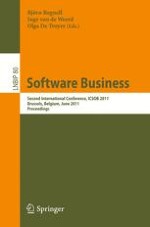This book contains the refereed proceedings of the Second International Conference on Software Business (ICSOB) held in Brussels, Belgium, in June 2011.
This year's conference theme "Managing Software Innovation for Tomorrow's Business" reflects the specific challenges in the research domain of software business. The 14 papers accepted for ICSOB were selected from 27 submissions covering topics like software ecosystems, usage of open source software, software as a service, and software product and project management. The volume is completed by a short summary of the keynote and the two workshops (EPIC 2011 "Third Workshop on Leveraging Empirical Research Results for Software Business," and IWSECO 2011 "Third International Workshop on Software Ecosystems") preceding the main conference.
